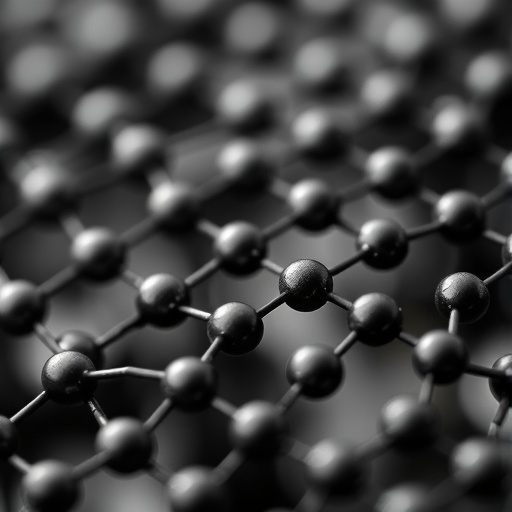Recent advancements in material science have unveiled an innovative approach to enhancing the electrochemical performance of quasi-solid polymer electrolytes. Researchers led by Choudhury, Viswanathan, and Balamoorthy have focused their study on incorporating two-dimensional graphene nanoplatelets into a polymer mixture composed of polyethylene oxide (PEO) and polylactic acid (PLA). Their findings, soon to be published in the renowned journal Ionics, indicate a significant leap forward in the development of more efficient and stable energy storage systems.
Graphene nanoplatelets are a form of carbon characterized by their exceptional electrical conductivity, mechanical strength, and thermal properties. When integrated into polymer matrices, these nanoplatelets can significantly alter the physical and electrochemical properties of the resulting composite materials. The combination of PEO and PLA has already shown promise in various applications, but the introduction of graphene nanoplatelets provides a significant enhancement in overall performance.
The study aims to bridge the gap between traditional liquid electrolytes and solid-state batteries by creating quasi-solid polymer electrolytes that are less prone to leakage and thermal runaway, making them safer and more efficient for future energy storage solutions. In their experimentation, the researchers meticulously analyzed how varying concentrations of graphene nanoplatelets influenced the electrochemical properties of the PEO/PLA matrix.
One of the standout findings of the research is the notable increase in ionic conductivity with the addition of graphene nanoplatelets. Conductivity is a critical parameter for electrolytes, as it directly impacts the power density and overall performance of batteries. The researchers discovered that even a small percentage of graphene incorporation could lead to vast improvements. These advances suggest that not only does this combination enhance conductivity, but it also contributes to the mechanical integrity of the polymer composite.
In addition to improving ionic conductivity, the study also examined other parameters such as thermal stability and electrochemical stability. The presence of graphene nanoplatelets within the polymer matrix demonstrated significant ameliorations in thermal behavior. With growing concerns about battery safety, especially in electric vehicles and portable electronics, improvements in thermal stability could lead to a new standard in battery design and technology.
Throughout their experiments, the team utilized a range of sophisticated characterization techniques to analyze the composites’ properties. Techniques such as scanning electron microscopy (SEM) and transmission electron microscopy (TEM) were employed to explore the dispersion and structural integrity of the graphene nanoplatelets within the polymer matrix. These insights are crucial for understanding how the material behaves under operational conditions and ultimately dictate its functional performance.
The researchers also conducted extensive electrochemical testing to assess the performance of their developed quasi-solid polymer electrolytes. By employing techniques like cyclic voltammetry and impedance spectroscopy, they provided a comprehensive overview of how the electrochemical characteristics changed with varying nanoplatelet content. This data not only reinforces the utility of graphene in improving ion transport but also showcases the potential for creating new energy storage architectures.
Another critical aspect of the research is the environmental impact of the materials used. Both PEO and PLA are noted for their biodegradable and non-toxic properties, making them suitable candidates for sustainable energy applications. Integrating graphene nanoplatelets further enhances the commercial viability and environmental footprint of the material, aligning with the increasing global interest in green technologies.
Ultimately, these advancements could contribute to the development of next-generation batteries with vastly improved efficiency, safety, and sustainability. As the research progresses, the implications for renewable energy storage systems, electric vehicles, and portable electronics could be profound, potentially leading to a paradigm shift in how we utilize energy-conversion technologies.
The future prospects of the research team highlight ongoing efforts to further refine the electrochemical performance of these quasi-solid polymer electrolytes. This includes exploring alternative nanoparticles, optimizing the manufacturing process, and scaling up production for commercial applications. Such endeavors could significantly impact the energy landscape, fostering innovations that enhance both consumer products and broader energy infrastructure.
In conclusion, the work being undertaken by Choudhury, Viswanathan, and Balamoorthy stands at the forefront of battery technology innovation. With their promising findings regarding graphene nanoplatelets in PEO/PLA polymer mixtures, they not only pave the way for enhanced electrochemical performance but also reinforce the importance of integrating sustainable materials in future energy solutions. As researchers continue to explore the potential of these materials, the world may soon witness a new evolution in energy storage technology that is faster, safer, and more efficient than ever before.
This groundbreaking study is set to appear in December 2025, ahead of an exciting period for advancements in the field of energy storage, making it a point of interest for researchers and industry leaders alike. The future looks bright for the integration of innovative materials in developing next-generation battery technologies!
Subject of Research: Polymer Electrolytes and Energy Storage
Article Title: Two-dimensional graphene nanoplatelets incorporated PEO/PLA polymer mixture for the enhanced electrochemical performance of quasi-solid polymer electrolytes.
Article References:
Choudhury, A., Viswanathan, G., Balamoorthy, E. et al. Two-dimensional graphene nanoplatelets incorporated PEO/PLA polymer mixture for the enhanced electrochemical performance of quasi-solid polymer electrolytes.
Ionics (2025). https://doi.org/10.1007/s11581-025-06824-x
Image Credits: AI Generated
DOI:
Keywords: Graphene Nanoplatelets, Polymer Electrolytes, Electrochemical Performance, Energy Storage, Sustainable Materials.




